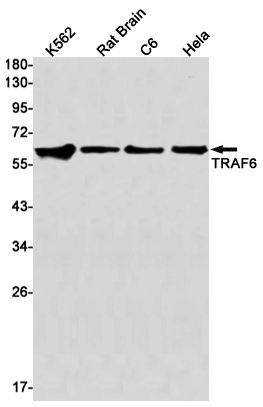
| WB | 1/500-1/1000 | Human,Mouse,Rat |
| IF | 咨询技术 | Human,Mouse,Rat |
| IHC | 咨询技术 | Human,Mouse,Rat |
| ICC | 技术咨询 | Human,Mouse,Rat |
| FCM | 咨询技术 | Human,Mouse,Rat |
| Elisa | 咨询技术 | Human,Mouse,Rat |
| Aliases | TRAF6; RNF85; TNF receptor-associated factor 6; E3 ubiquitin-protein ligase TRAF6; Interleukin-1 signal transducer; RING finger protein 85 |
| Entrez GeneID | 7189 |
| WB Predicted band size | Calculated MW: 60 kDa; Observed MW: 60 kDa |
| Host/Isotype | Rabbit IgG |
| Antibody Type | Primary antibody |
| Storage | Store at 4°C short term. Aliquot and store at -20°C long term. Avoid freeze/thaw cycles. |
| Species Reactivity | Human,Rat |
| Immunogen | A synthetic peptide of human TRAF6 |
| Formulation | Purified antibody in TBS with 0.05% sodium azide,0.05%BSA and 50% glycerol. |
+ +
以下是3-4篇关于TRAF6抗体的参考文献,按文献名称、作者和摘要内容简要概括:
---
1. **文献名称**: *TRAF6 is a signal transducer for interleukin-1*
**作者**: Cao Z, Xiong J, Takeuchi M, Kurama T, Goeddel DV
**摘要**: 该研究通过TRAF6抗体进行免疫共沉淀实验,揭示了TRAF6在IL-1信号通路中的核心作用,证明其通过激活NF-κB和MAPK通路参与炎症反应调控。
2. **文献名称**: *TRAF6-dependent CD40 signaling induces B7 molecules through activation of NF-κB*
**作者**: Kobayashi T, Walsh MC, Choi Y
**摘要**: 研究利用TRAF6抗体阻断实验,发现TRAF6在CD40介导的B细胞激活中不可或缺,通过调控NF-κB通路促进共刺激分子B7的表达,影响T细胞免疫应答。
3. **文献名称**: *Ubiquitin signaling in immune response and inflammation via TRAF6*
**作者**: Deng L, Wang C, Spencer E, Yang L, Braun A, You J, et al.
**摘要**: 通过Western blot和免疫荧光结合TRAF6抗体,阐明了TRAF6的泛素化修饰在TLR/IL-1R信号转导中的关键机制,及其在炎症性疾病中的潜在靶点作用。
4. **文献名称**: *TRAF6 inhibition suppresses osteoclastogenesis and breast cancer-induced osteolysis*
**作者**: Yang WL, Wang J, Chan CH, Lee SW, Campos AD, Lamothe B, et al.
**摘要**: 研究使用TRAF6特异性抗体抑制其活性,证实TRAF6在乳腺癌骨转移中促进破骨细胞分化的功能,为靶向TRAF6治疗骨破坏提供依据。
---
这些文献涵盖了TRAF6在炎症、免疫调控、泛素化信号及癌症中的功能研究,均涉及TRAF6抗体的实验应用(如Western blot、免疫沉淀或功能抑制)。
TRAF6 (Tumor Necrosis Factor Receptor-Associated Factor 6) is a key adaptor protein in intracellular signaling pathways, particularly those mediated by Toll-like receptors (TLRs), interleukin-1 receptors (IL-1Rs), and the TNF receptor superfamily. It plays a central role in activating NF-κB and MAPK pathways, regulating immune responses, inflammation, cell survival, and osteoclastogenesis. Structurally, TRAF6 contains a RING finger domain critical for its E3 ubiquitin ligase activity and a TRAF domain for interaction with upstream receptors or adaptors. Dysregulation of TRAF6 is linked to autoimmune diseases, cancers, and bone metabolism disorders.
TRAF6 antibodies are essential tools for studying its expression, post-translational modifications (e.g., ubiquitination), and interactions in signaling complexes. They are widely used in techniques like Western blotting, immunoprecipitation, immunofluorescence, and immunohistochemistry. Researchers often validate these antibodies using TRAF6-knockout cell lines to confirm specificity. Applications include investigating TRAF6's role in innate immunity, inflammation, or cancer progression, as well as screening therapeutic targets. Antibodies may be monoclonal (e.g., rabbit-derived clones for high specificity) or polyclonal (broad epitope recognition), with selection depending on experimental needs. Proper validation ensures reliable detection of TRAF6's dynamic functions across physiological and pathological contexts.
×